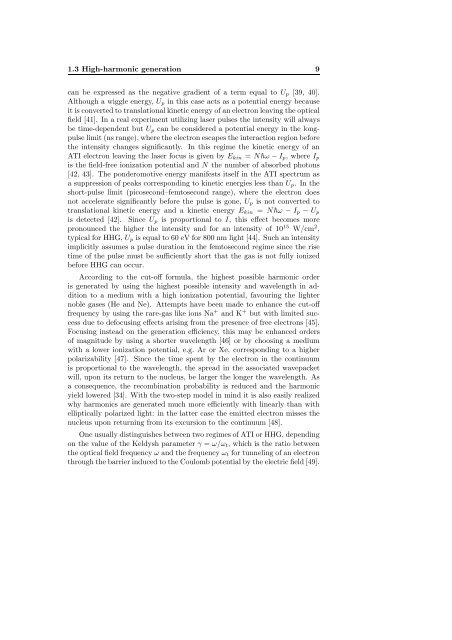VUV Spectroscopy of Atoms, Molecules and Surfaces
VUV Spectroscopy of Atoms, Molecules and Surfaces
VUV Spectroscopy of Atoms, Molecules and Surfaces
Create successful ePaper yourself
Turn your PDF publications into a flip-book with our unique Google optimized e-Paper software.
1.3 High-harmonic generation 9<br />
can be expressed as the negative gradient <strong>of</strong> a term equal to Up [39, 40].<br />
Although a wiggle energy, Up in this case acts as a potential energy because<br />
it is converted to translational kinetic energy <strong>of</strong> an electron leaving the optical<br />
field [41]. In a real experiment utilizing laser pulses the intensity will always<br />
be time-dependent but Up can be considered a potential energy in the longpulse<br />
limit (ns range), where the electron escapes the interaction region before<br />
the intensity changes significantly. In this regime the kinetic energy <strong>of</strong> an<br />
ATI electron leaving the laser focus is given by Ekin = N�ω − Ip, whereIp<br />
is the field-free ionization potential <strong>and</strong> N the number <strong>of</strong> absorbed photons<br />
[42, 43]. The ponderomotive energy manifests itself in the ATI spectrum as<br />
a suppression <strong>of</strong> peaks corresponding to kinetic energies less than Up. Inthe<br />
short-pulse limit (picosecond–femtosecond range), where the electron does<br />
not accelerate significantly before the pulse is gone, Up is not converted to<br />
translational kinetic energy <strong>and</strong> a kinetic energy Ekin = N�ω − Ip − Up<br />
is detected [42]. Since Up is proportional to I, this effect becomes more<br />
pronounced the higher the intensity <strong>and</strong> for an intensity <strong>of</strong> 10 15 W/cm 2 ,<br />
typical for HHG, Up is equal to 60 eV for 800 nm light [44]. Such an intensity<br />
implicitly assumes a pulse duration in the femtosecond regime since the rise<br />
time <strong>of</strong> the pulse must be sufficiently short that the gas is not fully ionized<br />
before HHG can occur.<br />
According to the cut-<strong>of</strong>f formula, the highest possible harmonic order<br />
is generated by using the highest possible intensity <strong>and</strong> wavelength in addition<br />
to a medium with a high ionization potential, favouring the lighter<br />
noble gases (He <strong>and</strong> Ne). Attempts have been made to enhance the cut-<strong>of</strong>f<br />
frequency by using the rare-gas like ions Na + <strong>and</strong> K + but with limited success<br />
due to defocusing effects arising from the presence <strong>of</strong> free electrons [45].<br />
Focusing instead on the generation efficiency, this may be enhanced orders<br />
<strong>of</strong> magnitude by using a shorter wavelength [46] or by choosing a medium<br />
with a lower ionization potential, e.g. Ar or Xe, corresponding to a higher<br />
polarizability [47]. Since the time spent by the electron in the continuum<br />
is proportional to the wavelength, the spread in the associated wavepacket<br />
will, upon its return to the nucleus, be larger the longer the wavelength. As<br />
a consequence, the recombination probability is reduced <strong>and</strong> the harmonic<br />
yield lowered [34]. With the two-step model in mind it is also easily realized<br />
why harmonics are generated much more efficiently with linearly than with<br />
elliptically polarized light: in the latter case the emitted electron misses the<br />
nucleus upon returning from its excursion to the continuum [48].<br />
One usually distinguishes between two regimes <strong>of</strong> ATI or HHG, depending<br />
on the value <strong>of</strong> the Keldysh parameter γ = ω/ωt, which is the ratio between<br />
the optical field frequency ω <strong>and</strong> the frequency ωt for tunneling <strong>of</strong> an electron<br />
through the barrier induced to the Coulomb potential by the electric field [49].















